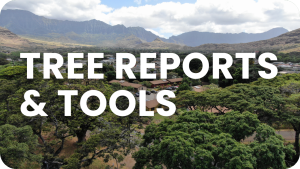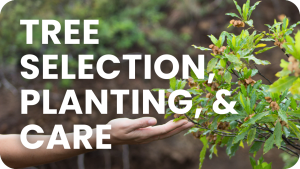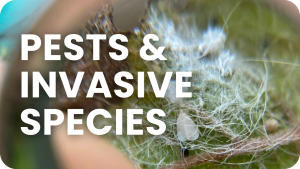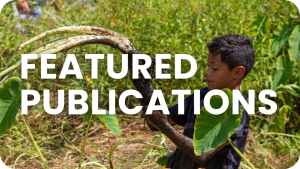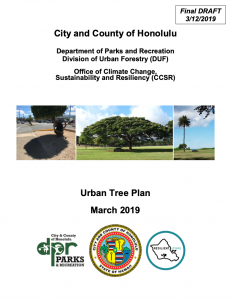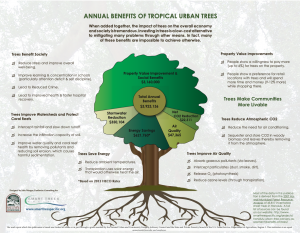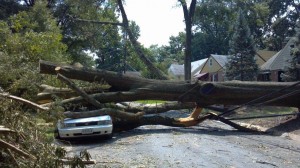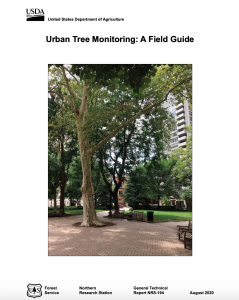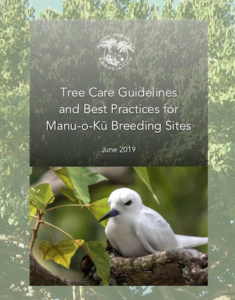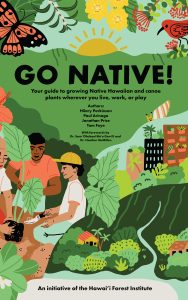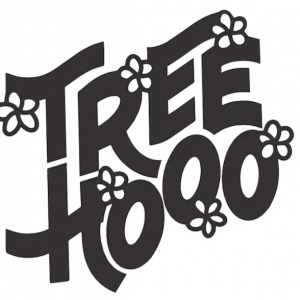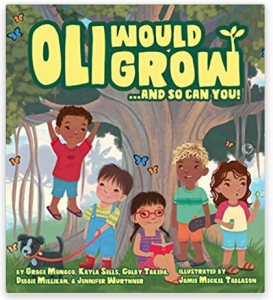Educational and Technical Resources
TREE REPORTS & TOOLS
City and County of Honolulu, Division of Urban Forestry (DUF) & Office of Climate Change, Sustainability and Resiliency (CCSR): Urban Tree Plan
|
Exceptional Tree Program“In 1975, the Hawai’i State Legislature found that rapid development had led to the destruction of many of the State’s exceptional trees and passed Act 105 – The Exceptional Tree Act. The Act recognizes that trees are valuable for their beauty and they perform crucial ecological functions. It mandates each county to establish a County Arborist Advisory Committee which enacts regulations to protect trees of exceptional stature. Each county has its own program, set of rules and operating guidelines.” City & County of Honolulu More information can be found on the program website hosted by the Online Map (City & County of Honolulu GIS) showing parcels with Exceptional Trees.
Kauaʻi County Maui County
|
Guide for Honolulu Tree Inquiries – City & County of HonoluluList of Honolulu contact information for inquiries related to trees. View the guide (PDF). |
Hawaiʻi Forest Action Plan; Issue Four: Urban and Community ForestryThe Kaulunani Program is guided by the State’s Forest Action Plan. The Kaulunani Council worked as part of the Hawai‘i Forestry team to analyze forest-related conditions, trends, threats, and opportunities within the State, to assure that federal, state, private and community resources focus on important issues. Issue Four: Urban and Community Forestry section from 2016 can be found here. |
Hawai‘i Municipal Forest Resource Analysis – City and County of Honolulu
|
Hawaiʻi Urban Tree Inventory Map – Citizen Foresters ProgramThe Citizen Foresters Program supports community members as volunteer citizen scientists to map urban trees and add to your community’s tree inventory while raising awareness on the importance of caring for trees where we live.
|
How Hawaii’s Counties Regulate TreesUrban Forestry County Regulation Reference Guide The purpose of this summary paper is to serve as a broad overview of all existing county regulations that function to regulate trees in some way for four of Hawai´i’s counties: City and County of Honolulu, Maui County, Hawai´i County, and Kaua´i County. The supplemental excel tables are to function as a county tree regulation reference of ordinances, charter sections, and general plan policies and objectives. Urban Forestry Research Tables The supplemental excel tables are to function as a county tree regulation reference of ordinances, charter sections, and general plan policies and objectives. Download the Reference Guide (415KB PDF) |
Maui County Planting Plan
|
Oahu Urban Tree Canopy Assessment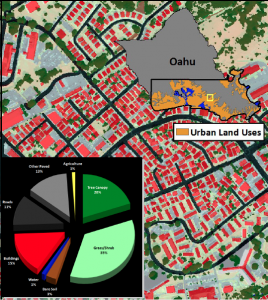 Urban Land Use features are shown along with existing tree canopy cover. Kaulunani has conducted two Urban Tree Canopy Assessments of the major urban centers of O‘ahu. The study area includes 250 square miles of Leeward and Windward O‘ahu. The initial assessment completed in 2012 identified where trees are located, the extent of the canopy, as well as ownership and potential planting sites for enhancing the urban tree canopy. In 2016, we conducted a second Urban Tree Canopy analysis to assess the degree of change our a four year period from 2010 through 2013. What we found was alarming. Honolulu is losing tree canopy; in fact, we lost nearly 5% of our total urban tree canopy over four years. The majority of losses were in non-public zoning areas. Net Residential losses alone totaled 355 acres representing 39% of all the tree canopy loss. All land use areas saw decreases; even our conservation areas saw a 1% loss in tree canopy. Close to 98% of the losses were less than a quarter acre each and spread widely across the landscape. These losses equate to at least 76,600 trees. New plantings did occur totaling about 230 acres, which is far short of what is needed to keep pace with the losses, especially considering the time required to grow a canopy.
|
Stewardship Mapping Assessment Project (STEW-MAP)Started by scientists at the USDA Forest Service Northern Research Station, STEW-MAP pinpoints where stewardship groups are improving their surroundings. STEW-MAP helps stewards find novel partners and gaps in coverage. The project also recognizes agents of change in vulnerable communities — furthering diversity, equity, and inclusion.” – USFS STEW-MAP Website To date, Oʻahu Kona and Koʻolaupoko and Hawaiʻi South Kona and North Kohala have been surveyed and mapped.
|
Tree Canopy ViewerThe Division of Forestry and Wildlife and the U.S. Forest Service have partnered to create the first interactive, online canopy viewer pae ‘āina in Hawai‘i. The viewer is free to access and available in full here. The canopy viewer aims to build upon our previous understanding of tree canopy in Hawai‘i. What does our tree canopy look like? Where is our tree canopy located? Is the distribution of tree canopy in Hawai‘i equitable? This tool could be used to answer these questions. The viewer could also be used to prioritize tree planting and maintenance where it can have the most impact for communities disproportionately burdened by risks that urban tree cover may help ameliorate. Learn more about the project at our webpage. |
Urban Forestry Emergency Operations Planning Guide for Storm Response
|
USFS Urban Tree Monitoring Resources
Urban Tree Monitoring: Field Guide: This US Forest Service report provides detailed protocols for urban tree monitoring data collection. It discusses the core variables necessary for field-based monitoring projects, including field crew identification, field crew experience level, tree record identifier, location, site type, land use, species, mortality status, crown vigor, and trunk diameter. The intent of this Field Guide is to serve urban forest managers and researchers who collect longitudinal field data on urban trees, as well as interns and citizen scientists. View the Urban Tree Monitoring: A field guide, August 2020 (PDF 6.0MB). Urban Tree Monitoring: A Resource Guide: The guidelines proposed in Urban Tree Monitoring: A Resource Guide (hereafter referred to as the Resource Guide) were developed and refined over many years to address the need for standardized urban tree monitoring protocols. The Resource Guide provides in-depth guidance for urban forest managers and researchers who want to design and implement a tree monitoring project. This Resource Guide is a companion to Urban Tree Monitoring: A Field Guide; however, the Resource Guide can also be used on its own. View the Urban Tree Monitoring: A Resource Guide , August 2020 (PDF 10.0 MB). |
Vibrant Cities LabThe USDA Forest Service and American Forests created Vibrant Cities Lab (Website) to serve as a free hub of the latest research, best practices, and tools from urban forestry experts. Includes case studies, publications, tools and guides. |
Spreading Roots Community Action ToolkitOn this page, you can download the free, informative Spreading Roots Community Action Toolkit Overview as well as a number of valuable communication and outreach tools and resources to help you launch your own local urban forestry initiatives. It serves as a guide for communicating the benefits of our urban and community forests. |
TREE SELECTION, PLANTING, AND CARE
NURSERY
USFS Reforestation, Nurseries and Genetic Resources (RNGR) programThe RNGR program provides technical information and resources to people who grow forest and conservation seedlings. The Tropical Nursery Manual: A Guide to Starting and Operating a Nursery for Native and Traditional Plants is a handbook for people looking to start and operate a nursery for native and traditional plants in the tropics. It includes information about starting a nursery and planning through nursery growing, outplanting, and ongoing learning. |
SELECTION
Kaulunani Selecting High Quality Trees GuidePlanting high-quality trees increases their rate of survival. These have strong stems of desired diameter, healthy root systems, no trunk damage or disease, and well-spaced branches. This guide provides tips to selecting high-quality trees from nurseries. Download the guide here (PDF). |
Plant Pono WebsiteFind pono plants for your yard. Search the database by color, growth form, and more! Visit the website. |
SelecTreeFind urban trees that match your landscape needs. Search the filterable tree selection guide or use the Pacific Islands Tree Key to identify your tree. |
PLANTING
Master Gardeners Program – University of Hawaiʻi College of Tropical Agriculture and Human ResourcesGeneral and species-specific information including tree planting and care. Visit the website. |
Planting Details and Specifications – International Society of ArboricultureDr. Ed Gilman from University of Florida, Jim Urban, FASLA, and Brian Kempf and Tyson Carroll of the Urban Tree Foundation have developed a modern, up-to-date, and peer reviewed set of details and specifications in AutoCAD, PDF, and Microsoft Word formats for the green industry. These are designed specifically for landscape architects, engineers, architects, contractors, urban foresters, arborists, municipalities, and state agencies. All these files are open source, free, and can be edited by the user.
ISA Planting Details and Specifications (Downloadables). |
Planting the Right Tree in the Right Place – HECO“Landscaping your property provides many benefits. Trees enhance our environment by cleaning the air, preventing erosion, and conserving watersheds. Trees also offer beautiful flowers, delicious fruit, and cooling shade. Following are some guidelines to help you plant the right tree in the right place.” View the booklet. |
Reef Friendly Landscaping – Maui Nui Marine Resource Council“Maui Nui Marine Resource Council has been researching these chemicals’ effects on coral reef ecosystems and human health. We are working with resorts in south Maui to make the switch to organic alternatives, and we encourage homeowners and our community to join us. Going organic helps create healthy, thriving, and biodiverse soil communities which make for happy plants and lawns, leading to low-maintenance care and cost savings in the future. Our Reef-Friendly Certification Program can help your property become an eco-tourism destination that is doing its part to protect Maui’s coral reefs and marine life.” Visit the website to learn more and enroll in the course. |
Standards and Procedures for the Planting of Street Trees – DUFView the document here (PDF). |
CARE
Aloha Arborist AssociationThe Aloha Arborist Association has been connecting the tree stewards of Hawaii with resources and providing opportunities for industry education and networking for 44 years! We are dedicated to teaching our communities the benefits of trees and how to care for this important resource. Visit their website for useful links and find the following downloadable guides (PDF): |
Firewise Tree Care and LandscapingTips for Firewise tree care and landscaping developed by Kaulunani in conjunction with the Hawaiʻi Wildfire Management Organization and the Firewise USA Hawaiʻi Program. |
Trees Are Good WebsiteProvides quality arboriculture and tree care-related information. You may also search the website’s online directory to find an Arborist near you. Visit the website. |
Tree Care Guidelines and BMPs for Manu-o-Ku Nesting Sites by the Aloha Arborist Association, 2019
|
EDUCATIONAL RESOURCES
Visit the Forestry and Wildlife Education homepage for more resources including curricula, outreach material, and classroom visits.
Community Forests Activities & Lesson PlansA diverse collection of activities and lesson plans for educators to use in and out of the classroom. Includes curricula & lessons on ʻulu, coloring & paper craft activities, and native plant diagrams. Originally gathered for the Year of Our Community Forests. Visit the webpage here. |
Hawaiʻi Urban Forest Website“Hawai’i Urban Forest is a project of Mālama Learning Center, a non-profit conservation education organization based in the growing city of Kapolei, O’ahu. Our mission is to inspire communities to care for Hawai’i by perpetuating conservation, culture, and sustainability through education. With students, teachers, and community volunteers, we grow thousands of native Hawaiian trees to build healthy and vibrant communities. In partnership with the City & County of Honolulu, Department of Parks and Recreation, Kaulunani Urban and Community Forestry Program, Trees for Honolulu’s Future, and many other groups, we have embarked on this project to promote growing and caring for urban forests.” Visit the website at http://www.hawaiiurbanforest.org/. |
Symphony of the Hawaiʻi Forests – Teacher ResourcesSymphony of the Hawai‘i Forests brings together music, art, science, hula, and storytelling to better connect the keiki with the forests of Hawai‘i through an immersive performance that fully embodies the collaborative spirit. Mālama Learning Center (MLC) compiled the Teacher Resources slides with great information about Hawaiʻi’s forests through videos, lesson plans, and technical guides. Visit the website. |
Why Are Trees Important? – KaulunaniTrees literally hold our island state together. They help define Hawaii’s sense of place, that special connection between our diverse cultures and the environment, the land and its people. While trees in urban areas may appear to have a different function than trees in the natural forest, they often are the first connection that communities have to nature. Visit our webpage to learn more about the benefits of trees. |
Why Would Anyone Cut A Tree Down“We may not want to, but sometimes we need to…” A children’s book about the benefits of trees and why sometimes, we have to cut them down. Includes tips for choosing and planting right. Download the book (1.6 MB PDF). |
Forests for Life – Hoʻoulu ʻĀinaTake a virtual huakaʻi to Hoʻoulu ʻĀina in Kalihi valley, Oʻahu, to learn more about their community forest programs and how they connect people to place. View the video clip here. |
PESTS & INVASIVE SPECIES
Coconut Rhinoceros Beetle Pamphlet – USDAInformation on the eradication effort for this pest recently discovered on Oahu and how to help! View the pamphlet (1.76MB PDF). |
College of Tropical Agriculture and Human Resources (CTAHR)Greenhouse and Nursery SanitationGuide to greenhouse and nursery sanitation practices to prevent and manage nursery pests. View the guide (PDF). Invasive Species and Pest Control publicationsSee Pests, Weeds & Diseases section for Invasive Species and Pest Control information including plant-specific and pest-specific documents. Visit the website. |
DLNR Outplanting Guide – Nursery Pest GuidelinesInformation on pest prevention, monitoring, and control recommendations in nurseries for projects that grow, purchase, or distribute plants in Hawaii. View the document (100 KB PDF). |
Hawaiʻi Ant LabInformation about Little Fire Ant. Visit the website. |
Hawaiʻi Invasive Species Information PortalPortal with links to Hawaiʻi invasive species organizations and information: Hawaiʻi Invasive Species Council, Island Invasive Species Councils, and Coordinating Group on Alien Pest Species Visit the portal. |
Hawaiʻi Pacific Weed Risk AssessmentThis is a screening tool to ask “background questions” about a plant before it is imported or widely planted in Hawai‘i. View Weed Risk Assessment scores and reports for thousands of plants found in Hawaiʻi. Visit the website. |
Laukahi Network – Hawaiʻi Rare Plant Restoration Group Phytosanitation Standards and Guidelines“The objective of this document is to state the level of sanitation that will be required during ex situ operations, and the transition into natural habitats via reintroduction or augmentation projects.” |
Pacific Islands Fish and Wildlife Service (PIFWO) Invasive Species Biosecurity Protocols“We recommend this biosecurity protocol be incorporated when project activities occur within any area containing predominantly native habitat. Project activities involving the transportation of a substantial amount of materials (i.e., construction materials or aggregate, etc.), vehicles, machinery, equipment, or personnel between sites should also incorporate the biosecurity protocols. Additional consultation with the Service is recommended if the project involves transportation of materials, equipment, vehicles, etc. between islands or transpacific movement. The Species-Specific Biosecurity Protocols should also be reviewed and implemented depending on the geographic area and/or specific activities of your project.” |
FEATURED PUBLICATIONS
MAGAZINE ARTICLES
- 2024 Hawaii Business Magazine: The Heat Is Rising in Honolulu. More Trees Will Help Cool It Off
- 2023 The Maui News: ‘Throwing shade’: Tree Canopy Critical as State Grapples with Climate Change
- 2021 Honolulu Magazine Article: Honolulu is Losing Trees When We Need Them More Than Ever. Can New Initiatives Save Us?
- 2016 Honolulu Star-Advertiser: “Schools see Trees as a Cool Solution for Hot Classrooms”
ACADEMIC PAPERS
Urban ʻĀina: An Indigenous, Biocultural Pathway to Transforming Urban Spaces (ʻĀina of Kaʻōnohi, et. al., 2023). Academic article exploring the concept of Urban ʻĀina and the practice of indigenous stewardship in urban spaces.
RESOURCES BY OUR PARTNERS
Grow Aloha – National Tropical Botanical Garden, 2023The Grow Aloha program places community at the heart of efforts to restore Hawaiian plants and their cultural connections in the built environment. The program spotlights a Hawaiian tree each month, gifting the respective native species or heritage crop to kamaʻāina at NTBG botanic gardens on Kauaʻi and Maui. This is coupled with accessible community education in the form of webinars and “how-to” videos, to ensure horticultural success and broader reach across Hawaiʻi. By routinely giving away these trees and empowering our communities to grow them, NTBG is working towards ecological restoration and cultural preservation simultaneously, using the urban landscape as a site for transformation. Visit the website and check out the Grow Aloha Podcast and videos! |
Canoe Plant Tree Giveaways for the Health and Resiliency of the Lahui: A partnership for Kauaʻi and Molokai, 2020
|
Go Native: Growing a Native Hawaiian Urban Forest
|
|
Oli Would Grow, Children’s Picture Book by Blue Zones Project and Washington Middle School, 2019
|

